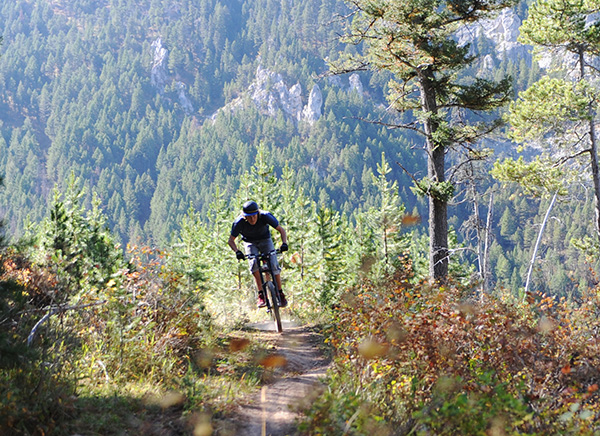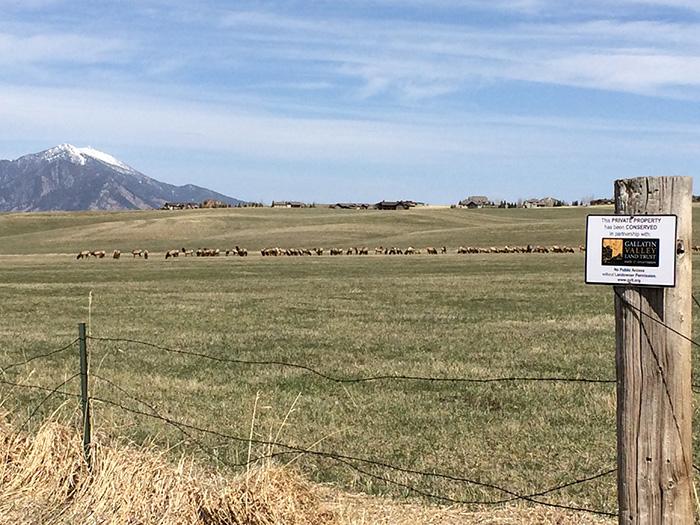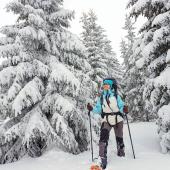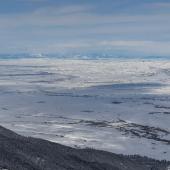Bonding Session
7 reasons to vote for open space.
On the back of your primary election mail-in ballot, a humble column of text reads, “Open Space Proposition.” You should vote for it. Here’s how it works in a nutshell: when the measure passes, the county will tax property at the rate of $6 per every $100,000 you own. That property tax is called a “mill levy,” and no, it’s not a million dollars. The Gallatin County Commissioners would like us to vote in favor of 4.5 mills; in 15 years, we’ll have raised more than $20 million.
The mills go into the hands of a few different parties. Some go to the county, some go to land trusts, and some go to landowners. Four of those mills are specifically set aside for land-conservation easements: that’s when a willing landowner sells development rights to a land trust, like the Gallatin Valley Land Trust or the Montana Land Reliance. Then, no one or thing can ever develop there—in perpetuity—barring some zombie-like event. One-half of a mill is set aside for Gallatin Valley Parks and trail improvements.
This program has been in place since 2000, and it ran out of funds mid-2017. Your vote renews a commitment that’s been creating opportunities and saving land for nearly two decades. The thing works! Plus, this new program’s mechanics are slightly different—see the “nitty gritty” below—and it will actually cost you less now than it has in the past. It’s kind of a no-brainer (no zombie pun intended).
When you mail in your ballot before June 5, or hit the polls on June 5, vote FOR a mill levy increase. Not only will you have the satisfaction of contributing to an incredibly important piece of local legislation, but you’ll also get a high-five from everyone at Outside Bozeman. Seriously: come into the office on June 5 with your “I Voted” sticker and take a picture of high-fiving action with the staff.
Now, five simple reasons, and another two less-simple but equally as important reasons, to vote for the mill levy.
The Secret Is Out
Gallatin Valley is a gem that needs to be protected from over-development and careless development. “We care, we’re connected to this place, but we are also at risk of loving it to death,” GVLT’s community outreach specialist EJ Porth says. “The secret is out, and if we want to strike a balance between growth and a vibrant economy, and the quality of life we love, we have to make investments.”
The numbers don’t lie. According to an April 2018 Headwaters Economics report, “Nearly half of homes built from 1990 to 2016 were constructed on large lots with average lot sizes exceeding 10 acres… Without careful planning for our future, conversion of undeveloped land to residential housing will be detrimental to Montana’s water quality, wildlife, and heritage of open space.” (Emphasis added by me.)
And the mind-blowing numbers keep coming: Gallatin Valley is the fastest-growing county in the state. Fifteen percent of all the homes built in Montana were built in this county since 1990, and Gallatin County has lost more open space than any other county in Montana during the same time. According to Bozeman Mayor Cyndy Andrus, who supports the Open Lands Proposition, “We live in the fastest-growing micropolitan city [a city under 50,000 people] in the COUNTRY.” (Emphasis added by mayor.)
“Bozeman is one of the most desirable places to live in the Rocky Mountain West,” Andrus says. “This is because we have a great quality of life.”
Porth says it all: “Great places don’t happen by accident.”
Farmers and Ranchers Need Our Help
Lots of farmers and ranchers who sell their development rights do it because they want to prevent development on primo ag land with magic soil. Becky Weed, who owns Thirteen Mile Lamb and Wool with her husband, was one of the first landowners to participate in the Open Lands Program. She did it primarily to protect agriculture.
“The trouble is, land has gotten so crazy expensive that most people who can afford the land are not the people who want to do all of the work,” Weed says. “I feel there is still a lot of valuable agricultural land that has not yet been paved over.”
She makes a good point when she says we won’t always be able to count on California to fill our grocery stores. Twenty years from now, Weed believes people who vote for the Open Lands Proposition will be glad they valued local food production. And she’s right: According to the United Nations’ Food and Agriculture Organization, “A world without hunger and malnutrition by 2030 will be challenging.” Food availability in the United States is already steadily declining.
“I think many people don’t take food production very seriously, but they do so at their own peril,” Weed says.
Here’s a big one: as Gallatin County grows and grows, farming is the only industry that is shrinking. “From 2000 to 2015, Montana has lost more farming jobs—2,258—than any other industry in the state,” a Headwaters Economics report from 2017 says. This county has the fastest-growing job market in the state, with 85 percent of new jobs coming from sectors such as real estate. The best way to turn the tide is to continue supporting the Open Lands Program.
You’ll Preserve Wildlife, Water, and Recreation
Conservation easements—in which voluntary landowners give their development rights to land trusts simply in exchange for knowing their land won’t ever become a subdivision, plus a minor tax break—create safe spaces for Montana’s thriving wildlife. A vote for the Open Lands Program protects those creatures and their migration corridors that might become endangered due to development.
“Animals that have disappeared in many parts of the West are still abundant in Montana,” the Montana Wildlife Federation says. “At the same time, many species are in decline due to habitat loss. When species reach the brink of extinction, recovery efforts become costly and controversial. By taking action to prevent wildlife from becoming endangered, we can improve the likelihood of success, save taxpayer dollars, and reduce conflict over the Endangered Species Act.”
Easements also protect the water quality of streams and rivers by filtering runoff and reducing erosion. That, for one, protects prized fishing sites. Importantly, keeping land undeveloped and pristine will help keep nasty contaminants out of our drinking water. The case for water quality practically makes itself. Investing in the Open Lands Program does just that.
An important part of the Open Lands Program is designed specifically to fund recreation in the area. That means maintenance and upkeep at the Gallatin County Regional Park, protecting forest lands for trails, and improving existing trails across the valley. Conservation easements also ensure that for you hunters out there, land stays with the landowner; with an easement on a ranch, the hunting exchange remains the same. Simply look to my next point for the importance of the Open Lands Program in outdoor recreation.
This Program Works
Since 2000, when the Open Lands Program was developed, amazing things have appeared all around us, whether we knew it was because of the program or not. The $20 million built the 100-acre Gallatin County Regional Park; it created the Chestnut Mountain and North Cottonwood trailheads; and it conserved a whopping 50,000 acres of open land. We need to renew our efforts to protect vulnerable open land, and more amazing sights will appear before our eyes.

Chestnut Mountain trail, created with funds from the Open Lands Program
“With the pace of development and the loss of open land we’re experiencing… now is the time to reinvest, recommit, and take responsibility for caring for the future of this place,” Porth says. “The Open Lands Program is a tool that has worked, so let’s allow it to keep working. There is such a thing as ‘too late.’”
We Have a Damn Responsibility
Isn’t it freaking awesome that we get to live here? The least we can do is save it from becoming Anytown, U.S.A. The Gallatin Valley is estimated to add another 12,000 people over the next three years; they will have the same privilege and the same responsibility as do lifelong residents of the area. Growth will happen—let’s get it right.
“We can’t stop growth,” Porth says. “The ‘if we grow’ conversation doesn’t get us anywhere, but the ‘how we grow’ conversation, there’s power in that. We can decide how we want this place to look in the future. The alternative, not doing anything to think ahead and take the long view, that leaves us with the risk of losing what we love about this place.”
We could take our chances and vote against the Open Space Proposition, but in 20 years we’ll have turned the place we love to live into the place we live to get by. And that’s not why we live here. We should all carry the not-so-burdensome burden of a $6 yearly tax increase for every $100,000 of property owned. And remember, that's only if you own property; if you rent, you get a free ride.
“We have a great quality of life,” Andrus says, “which includes clean air and water, proximity to outdoor recreation, a nationally recognized research university, great schools, excellent health care, and a robust and diverse economy.”
Next up, the nitty-gritty.
Mill Levies Are Better Than Bonds
In 2000 and 2004, Gallatin County passed the Open Space Program using bonds to fund the project. However, this time around, the project will be funded by mill levies. Here’s the difference between a mill levy and a bond, and why it matters:
A bond is akin to an IOU. In the bonds that passed in 2000 and 2004, the county bought bonds from outside investors, then the county paid back the investors at a variable interest rate set by the county. (As an incentive for investors, the repaid interest was non-taxable—I’ll come back to that.) The county paid interest semiannually, but it still hasn’t been paid off, leaving landowners with a pile of bond debt.
County Commissioner Steve White says the county is paying off $11 million from the previous Open Lands bonds. Now, a resident who owns $350,000 in property pays about $24 a year. However, because a bond’s interest rate is variable, and rates over the next 15 years will almost certainly go up more than they did between 2000 and 2017—during which time interest rates remained level and even dropped—taxpayers would pay more under a new bond than a mill levy.
A mill levy is a property tax; it’s a straight flow of money from the taxpayers to the county and the land trusts. That’s great, because outside investors are out of the picture, and all the money for Open Lands stays within our community. No random, wealthy investor from SoCal gets to make money off your land then put an eyesore of a mansion in front of your view of the Bridgers.
What’s really smart about mill levies is that they increase in value from year to year. According to County Commissioner Steve White, “Mill levies are a much more economical way of funding open space than bonds.” Mills increase in value based on the county’s total taxable property values, as more people move to the area—giving you more bang for your buck. “The mill levy will cost voters less in the long run and actually deliver more,” County Commissioner Joe Skinner told the Bozeman Daily Chronicle.
And—yeah, it gets better—unlike a bond, a mill levy is more likely to pass in an off-year primary election, because a mill levy requires fewer votes to pass than a bond. That does NOT mean you shouldn’t vote. Also, a bond can’t be used for maintenance fees; with the mill levy, .5 out of 4.5 mills will go toward upkeep and renovation at the Gallatin County Regional Park, and improving local trails.
Valley views from the North Cottonwood trailhead
White says given the amount of money the county is asking from taxpayers on June 5, raising money using bonds would theoretically result in $12 million in interest; using mill levies, there is no interest attached, and property taxes only change year-to-year by cents, not dollars. Let’s do the math: someone with $350,000 in property would pay about $30 per year; compare that to the current remaining bond debt, where someone with $350,000 in property pays about $24 a year. (Yes, you will still pay both taxes until the bond debt is paid off.) At face value, you’re paying $6 more a year for a mill levy. Except that bonds are paid off with variable interest, meaning you’re likely to pay way more than $30 a year under a new bond as interest rates go up, up, up.
Your Taxes Don’t Go to Wealthy Landowners
Contrary to what many taxpayers understand, the Open Land Program comes at a relatively hefty price to farmers and ranchers. The value of program participants’ land depreciates significantly once they relinquish development rights. Landowners sell development rights—which is not mandated, but done at their own discretion—to land trusts for conservation easements.
But landowners don’t get paid fair market value. If they can afford it, landowners may donate any amount of the conservation easement value back into a stewardship fund; that donation is tax deductible, because it’s considered a charitable donation, which offsets their income taxes. If they can’t afford a donation or transaction fees, however, GVLT rolls real-estate transaction costs into the application for funding from the Open Lands Program.
“Landowners are certainly making a sacrifice,” Porth says. “Many have family who have worked the land for five or six generations. It is in their blood, it’s their livelihood, their retirement plan. We need to try and partially compensate them for property rights they’re giving up, and the value they’re sacrificing in their land.”
Porth says when they work with a landowner, GVLT rolls transaction costs into the application for funding from the Open Lands Program. “Some landowners only request transaction costs and donate the rest of the conservation easement value,” she says, “and some landowners need financial help for transaction and some partial compensation for the easement rights.”
Becky Weed of Thirteen Mile says she wanted to protect her land from developers, but still needed around $20,000 for real estate transaction fees to sell her easement—money she didn’t have, and so received it from GVLT.
“We never got into this as a way to make money, but I can't be too casual,” Weed says. “I gave up my career as a geologist to work in agriculture—I gave up a lot of money. If I had any desire to make a lot of money, someone would build a mansion on my land, and I don’t want to see that happen to this valley.”
Neither do we.
To learn even more, visit foropenlands.org. And don't forget: FLIP YOUR BALLOTS OVER ON JUNE 5.











